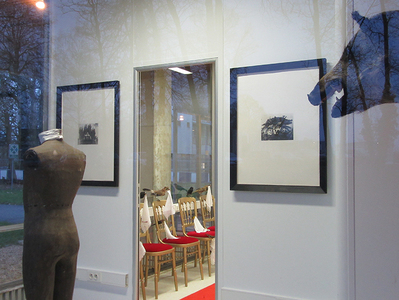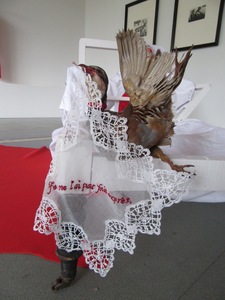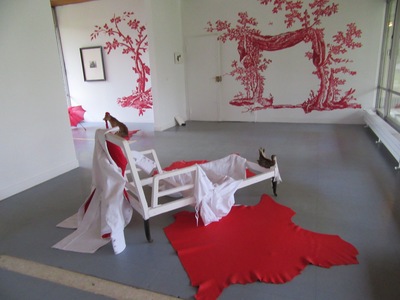KIVLAND, Sharon (2018). Entreprise de séduction : une exposition pour redécouvrir la Manufacture Oberkampf et toutes les contradictions de son époque. [Show/Exhibition] [Show/Exhibition]
Documents
21350:475002
21350:475005
21350:475006
21350:475007
21350:475008
21350:475009
21350:475010
21350:475011
21350:475013
21350:475014
21350:475015
21350:475017
21350:475018
21350:475019
21350:475020
21350:475021
Abstract
This is an exhibition in five parts, each corresponding to a room in the exhibition space. The work developed from research on the Manufacture Oberkampf in the archives of the Musée de la Toile de Jouy, and the exhibition will be followed by a publication in 2019, with texts by Fabienne Bideaud, Johan Hartle, Jean-Marc Huitorel, Elisabeth Lebovici, Adrian Rifkin and Sophie Wahnich. The period of activity of the Manufacture Oberkampf spans early industrial development in pre- revolutionary France to its closure in 1843; the end of the empire marks the decline of the enterprise. The Manufacture may be noted for the ‘benevolent’ factory conditions, the pastoral and political images of the printed cloth it produced, and its somewhat concealed relation to the colonial enterprise. Oberkampf’s factory displayed the conditions of production of the transition to what E. P. Thompson calls ‘industrial capitalism’, not only in the changes in techniques of manufacture that demand greater synchronisation of labour and increasing exactitude in time-routines, but also in how these changes are lived through. A ‘factory system’ and a ‘domestic system’ overlap.
The works address the complex relations between desire and consumption under capitalism, reconceptualising as the capture and remoulding of desire. Two figures set the boundaries: Rousseau and Robespierre, both present as corpses in some form: the tomb of the former, as an etching derived from a toile de Jouy, and the latter as the cadaver of a headless mannequin. The works are conceived as objects with the form of visual literacy. They have material agency. They are seen. They are read.
]
The exhibition is composed of five tableaux. Each provides a scene or staging. Each incorporates similar elements in different forms: skin, furniture, image/s, naturalised creatures, and an object or objects made by hand, by a skilled producer in four cases, by a diligent amateur in the fifth. In each scene there is a reference drawn from the Manufacture Oberkampf.
More Information
Statistics
Downloads
Downloads per month over past year
Share
Actions (login required)
 |
View Item |


 Tools
Tools Tools
Tools![[thumbnail of Entreprise de séduction]](https://shura.shu.ac.uk/21350/1.hassmallThumbnailVersion/01.jpg)

![[thumbnail of 02.jpg]](https://shura.shu.ac.uk/21350/2.hassmallThumbnailVersion/02.jpg)

![[thumbnail of 04.jpg]](https://shura.shu.ac.uk/21350/3.hassmallThumbnailVersion/04.jpg)

![[thumbnail of 08.jpg]](https://shura.shu.ac.uk/21350/4.hassmallThumbnailVersion/08.jpg)

![[thumbnail of 09.jpg]](https://shura.shu.ac.uk/21350/5.hassmallThumbnailVersion/09.jpg)

![[thumbnail of 12.jpg]](https://shura.shu.ac.uk/21350/6.hassmallThumbnailVersion/12.jpg)

![[thumbnail of 14.jpg]](https://shura.shu.ac.uk/21350/7.hassmallThumbnailVersion/14.jpg)

![[thumbnail of jabot and boar.jpg]](https://shura.shu.ac.uk/21350/8.hassmallThumbnailVersion/jabot%20and%20boar.jpg)

![[thumbnail of Jabot.jpg]](https://shura.shu.ac.uk/21350/9.hassmallThumbnailVersion/Jabot.jpg)

![[thumbnail of SK.jpg]](https://shura.shu.ac.uk/21350/10.hassmallThumbnailVersion/SK.jpg)

![[thumbnail of Fox.jpg]](https://shura.shu.ac.uk/21350/11.hassmallThumbnailVersion/Fox.jpg)

![[thumbnail of IMG_2517.jpg]](https://shura.shu.ac.uk/21350/12.hassmallThumbnailVersion/IMG_2517.jpg)

![[thumbnail of IMG_2543.jpg]](https://shura.shu.ac.uk/21350/13.hassmallThumbnailVersion/IMG_2543.jpg)

![[thumbnail of IMG_2530.jpg]](https://shura.shu.ac.uk/21350/14.hassmallThumbnailVersion/IMG_2530.jpg)

![[thumbnail of IMG_2523.jpg]](https://shura.shu.ac.uk/21350/15.hassmallThumbnailVersion/IMG_2523.jpg)

![[thumbnail of IMG_2570.jpg]](https://shura.shu.ac.uk/21350/16.hassmallThumbnailVersion/IMG_2570.jpg)

